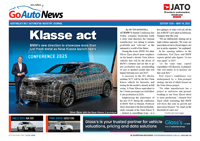News - Hyundai - NeptuneHyundai floats Neptune nameWater only: Hyundai’s Nexo (left) might not be going solo as the company’s only hydrogen fuel cell car for long, judging by Hyundai’s Neptune trademark application. Hydrogen fuel cell future spelled out in Hyundai’s Neptune trademark10 Oct 2019 AS GOD of the sea for the Romans, Neptune presumably had a fair bit to do with water. As hydrogen fuel cell electric vehicles (FCEVs) emit only water, it does not take too much of a stretch of the imagination to see why Hyundai Motor Group has reserved the Neptune name for a probable new vehicle running on hydrogen.
The trademark application lodged recently with Australian authorities by the South Korean company actually mentions “hydrogen fuel cell electric vehicles in the nature of hydrogen fuelled cars” in the description of the trademark’s use, while also referencing “automobiles” and “electrically powered trucks”.
If it eventuates, the Neptune could be a vital link in Hyundai’s grand plan to produce 500,000 FCEVs a year – a quarter of the expected global production – by 2030 under the company’s FCEV Vision 2030 program announced last December.
Hyundai already produces one of the few commercially available hydrogen fuel-cell cars, the Nexo, in South Korea where its subsidiary, Hyundai Mobis, recently opened a second fuel cell production factory to ramp up production from 3000 a year in 2018 to 40,000 a year in 2022.
In league with its partner Kia, Hyundai and its suppliers are investing almost $A10 billion in its fuel cell development and manufacturing program for both vehicles and other purposes.
Apart from cars and trucks, Hyundai sees a future for fuel cells in drones, boats and ships, trains and forklifts.
Apart from the 500,000 fuel cell stacks it intends to make for its own cars and trucks by 2030, it also plans to make a further 200,000 for these other purposes.
In a report last year, McKinsey and Company predicted world demand for fuel cell stacks would reach between 5.5 million and 6.5 million by 2030.
In Australia, Hyundai’s FCEV rollout is still at the experimental stage, with the Australian Capital Territory (ACT) government taking delivery of 20 Nexos fuelled by hydrogen made from electricity produced at the Hornsdale wind farm.
The cars have a driving range of about 660km on a tank which can be refuelled in a few minutes at a special station in the Canberra suburb of Fyshwyk.  Read more |
Click to shareHyundai articlesResearch Hyundai Motor industry news |
















Facebook Twitter Instagram